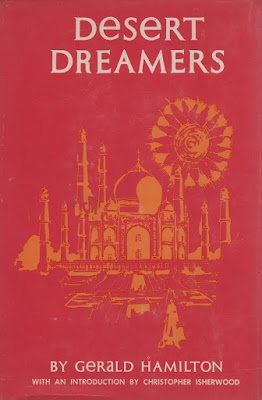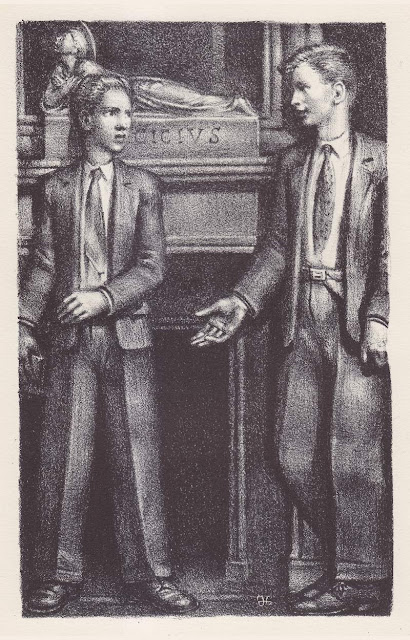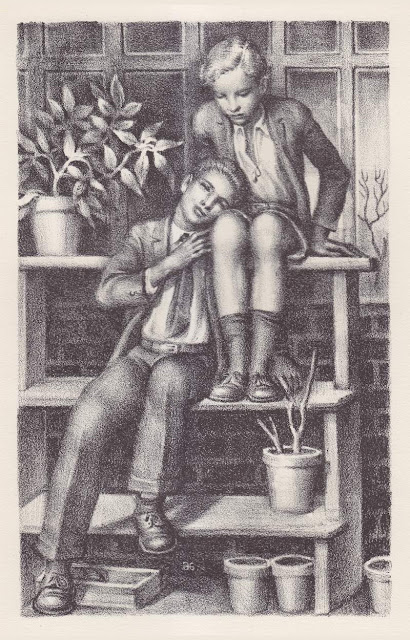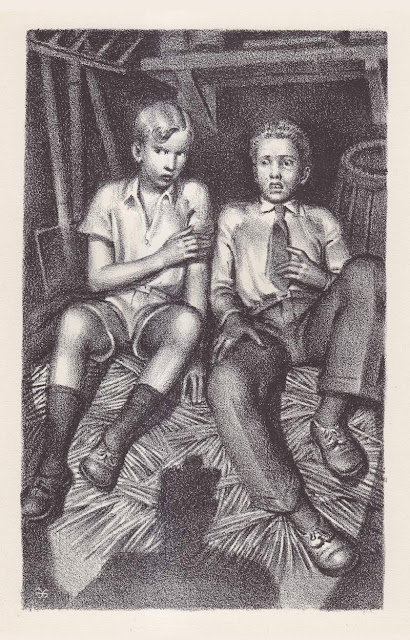 |
| Saint Sebastian (c.1915) Roberto Montenegro (Mexican, 1885-1968) |
Monday, September 11, 2017
Friday, August 25, 2017
The Green Waterways by Henry Scott Tuke
 |
| The Green Waterways (1926) Henry Scott Tuke (English, 1858-1929) Oil on canvas 48 x 44 in. Photo credit: Grundy Art Gallery |
Wednesday, August 9, 2017
Desert Dreamers by Gerald Hamilton
 |
| Washington D.C. : Guild Press, 1966 |
Making the acquaintance of a Frenchman at the hotel in Algiers, he shares with him that he plans to continue on to Biskra. The Frenchman is alarmed and tries to talk him out of it by stating that Biskra isn't the place for an Englishman like himself.
Julian's mind, however, is made up. Upon his arrival in Biskra he runs into a friend of his mother's, a barrister named Joseph Hoxton. When he is introduced to Hoxton's guide, Tayeb ben Mahmud, a young Algerian, he is instantly drawn to him.
Hamilton refers to Julian having read The Garden of Allah as the source of his desire to travel to Biskra. The Garden of Allah is a 1905 novel by Robert Smythe Hichens (author of the 1894 novel about Oscar Wilde, The Green Carnation) about an English woman of 32 years who has yet to find love. Her parents are deceased so she travels to Algeria with her maid and finds love in the desert.
Another reference, and likely the one that the Frenchman in the novel is reacting to, is the connection of Biskra with Oscar Wilde, Lord Alfred 'Bosie' Douglas, and Andre Gide. Gide has written about Wilde and Douglas traveling to Biskra and as part of their vacationing, picking up young local men. When Gide visited them, they introduced him to the lifestyle and the many young men who were available to European tourists.
Desert Dreamers would have been very bold for its time, thus the need for a pseudonym. Prior to each chapter, there is a short poem or poem fragment relating to the action of the text. They are not at all subtle. They include everything from Shakespeare to The Koran. One of my favorites is this one by Lord Alfred Douglas.
Jacinth blue and violet
Is the radiant light that flashes
Through the tangled silken net
When he lifts his languid lashes.
It is said that Gerald Hamilton is the source of Isherwood's Mr. Norris. In 1966, Guild Press re-released the complete text of Desert Dreamers under the author's actual name with a forward by Christopher Isherwood where he discusses this.
Bibliographies & Ratings: Young (At the Sign of the Tiger Lily edition, 4070* ; Guild Press edition, 1675*)
Monday, July 31, 2017
Tuesday, July 25, 2017
Thursday, July 13, 2017
Mask of Flesh by Maxence van der Meersch
 |
| London : William Kimber, 1960 Translated from the French by Mervyn Savill |
Emmanuel Ghelens, born in the years before WWI, obsesses over the effect of having had the prototypical controlling, 'masculine' mother has had on his life. During the war, his parents send him to boarding school. He describes his introduction to sex and his desire to create a lasting bond with the other boys. For them, it was simply physical. At the age of 18, he was picked up by an older man in Antwerp. Although he describes being disgusted with himself after the experience, he also began to make the connection in his own mind of his behavior and that of female prostitutes. They also (unwittingly) are searching for a little tenderness ... each time surrendering a little piece of their heart.
He soon begins to describe himself as a depraved monster or as having a monster living inside him. "It had made me a prisoner, a slave of the flesh." (p.39) After consulting a priest who told him that he was damned, he decides to live in solitude to avoid corruption. He knows that he will be open to robbery and blackmail if he doesn't.
A short time later, he meets Seddik, an Algerian man who had turned to prostitution in order to survive. Seddik was really looking for a friend and had found one in Emmanuel. While traveling, Emmanuel falls ill and when he is finally able to return, Seddik has disappeared. This is a huge loss for Emmanuel. Seddik was a prospect for hope and possible redemption. He had found love ... and had now lost it. He was now a prisoner again.
For a digitized archival collection of material related to the author (including correspondence regarding the manuscript for Masque de Chair), visit Archives de Maxence van der Meersch at Bibliothèque Numérique de Roubaix (in French).
Bibliographies & Ratings: Young (2641*)
Tuesday, July 4, 2017
Tuesday, June 6, 2017
The Gemlike Flame by Louis Auchincloss
 |
| Venice: Under the Rialto Bridge (1909) John Singer Sargent (American, 1856-1925) Watercolor Museum of Fine Arts, Boston |
The Gemlike Flame originally appeared in New World Writing, 3rd Mentor Selection (1953) and was subsequently issued in the short story collection, The Romantic Egoists (Houghton Mifflin, 1954). This story highlights the struggle between a 1950s understanding of a male-male relationship and an earlier, more chaste understanding such as appears in Edward Prime-Stevenson's Imre: A Memorandum (originally published under the pseudonym, Xavier Mayne in Naples, Italy, 1906) or The Strange Confession of Monsieur Montcairn (published anonymously, 1928).
The story opens in Venice as Peter Wescott is visiting his slightly older expat cousin, Clarence McClintock. Clarence summers in Venice each year and is described as 'impossibly choosy in his acquaintance'. More interested in the art and culture of Italy, he has no interest in making friends among the Italians or the visiting Americans. He has a particular distaste for "the artists and writers whom he regarded with chaste suspicion as people of unorthodox sexual appetite who had come to the funny land of love in search of tolerance that was not to be found in the justly censorious places of their origin." (Romantic Egoists, p.183)
When Peter introduces Clarence to his friend, Neddy Bane, they immediately hit it off. Neddy, an irresponsible, boyish-looking artist plans to return to New York after running out of money, but when Clarence offers to move him into his apartment, he stays. Clarence offers order and discipline to Neddy, sending him off each morning to sketch and then providing a place to paint each afternoon. Peter immediately understands what's in it for Neddy but when he asks what's in it for Clarence, Clarence replies, "Well if you don't see that, Peter, what do you see? It's what I have always waited for." (Romantic Egoists, p194)
When Clarence's mother, Maud Dash, arrives from New York for the Lorisan Ball, she asks Peter about Clarence's 'boyfriend'. It soon becomes apparent that there is no clear consensus on the nature of Clarence and Neddy's relationship.
Bibliographies & Ratings: Cory (I); Garde (OTP, c); Mattachine Review (I); Young (132)
The story opens in Venice as Peter Wescott is visiting his slightly older expat cousin, Clarence McClintock. Clarence summers in Venice each year and is described as 'impossibly choosy in his acquaintance'. More interested in the art and culture of Italy, he has no interest in making friends among the Italians or the visiting Americans. He has a particular distaste for "the artists and writers whom he regarded with chaste suspicion as people of unorthodox sexual appetite who had come to the funny land of love in search of tolerance that was not to be found in the justly censorious places of their origin." (Romantic Egoists, p.183)
When Peter introduces Clarence to his friend, Neddy Bane, they immediately hit it off. Neddy, an irresponsible, boyish-looking artist plans to return to New York after running out of money, but when Clarence offers to move him into his apartment, he stays. Clarence offers order and discipline to Neddy, sending him off each morning to sketch and then providing a place to paint each afternoon. Peter immediately understands what's in it for Neddy but when he asks what's in it for Clarence, Clarence replies, "Well if you don't see that, Peter, what do you see? It's what I have always waited for." (Romantic Egoists, p194)
When Clarence's mother, Maud Dash, arrives from New York for the Lorisan Ball, she asks Peter about Clarence's 'boyfriend'. It soon becomes apparent that there is no clear consensus on the nature of Clarence and Neddy's relationship.
Bibliographies & Ratings: Cory (I); Garde (OTP, c); Mattachine Review (I); Young (132)
Friday, May 19, 2017
Matin by Keith Vaughan
 |
| Matin (1943) Keith Vaughan (English, 1912-1977) Collage, pen and ink, crayon, wash and gouache 21 x 14 cm. |
Morning by Arthur Rimbaud
Didn't I once have a happy youth, heroic and fabulous, to be written on leaves of gold? Too much luck! By what crime, through what error, have I deserved my present weakness? You who maintain that animals sob with grief, that the sick despair, that the dead have bad dreams, try and give an account of my downfall and present slumber. I can no more explain myself than the beggar with his endless Paters and Ave Marias. I no longer know how to speak.
From the same wilderness, in the same night, my tired eyes always awaken to the same silver star; always, through the Kings of life, the three magi - the heart, the soul, the spirit - are not stirred. Where shall we go, beyond the shorelines and the mountains, to hail the birth of the new work, the new wisdom, the flight of tyrants and demons, the end of superstition, to worship - the first to do so! Christmas on Earth?
The song of heaven, the march of peoples! Slaves, let us not curse life.
Sunday, May 7, 2017
Front Free Endpaper: Gaston Goor Illustrates Les Amitiés Particulières
Les Amitiés Particulières by Roger Peyrefitte is widely considered one of the classic pieces of romantic schoolboy fiction. It is the story of an older and a younger boy in a French boarding school who become romantically attached and about the tragedy that ensues when the affair is discovered and mishandled by the priests who run the school. The 'affair' actually is no more than some passionate letters and a couple of stolen kisses. It was translated into English and made into a film and in 1953 Flammarion published a de luxe edition in two volumes with lithographic illustrations by Peyrefitte's favorite illustrator Gaston Goor.
 |
| Frontispiece, Volume I : Georges and Lucien flanking an angel Gaston Goor (French, 1902-1977) Les Amitiés Particulières by Roger Peyrefitte Paris : Flammarion, 1953 |
 |
| Title Page, Volume I : Georges reading a note with Lucien Gaston Goor (French, 1902-1977) Les Amitiés Particulières by Roger Peyrefitte Paris : Flammarion, 1953 |
 |
| Volume I : Georges observing the courtyard Gaston Goor (French, 1902-1977) Les Amitiés Particulières by Roger Peyrefitte Paris : Flammarion, 1953 |
 |
| Volume I : Georges and André in front of statue of Tarsicius Gaston Goor (French, 1902-1977) Les Amitiés Particulières by Roger Peyrefitte Paris : Flammarion, 1953 |
 |
| Volume I : Georges and Lucien at the piano Gaston Goor (French, 1902-1977) Les Amitiés Particulières by Roger Peyrefitte Paris : Flammarion, 1953 |
 |
| Volume I : Alexandre, Georges, and Lucien at communion Gaston Goor (French, 1902-1977) Les Amitiés Particulières by Roger Peyrefitte Paris : Flammarion, 1953 |
 |
| Volume I : Georges looking at Alexandre through the window Gaston Goor (French, 1902-1977) Les Amitiés Particulières by Roger Peyrefitte Paris : Flammarion, 1953 |
 |
| Volume I : Georges and Alexandre in the greenhouse Gaston Goor (French, 1902-1977) Les Amitiés Particulières by Roger Peyrefitte Paris : Flammarion, 1953 |
 |
| Volume I : Georges in the office of the Superior Gaston Goor (French, 1902-1977) Les Amitiés Particulières by Roger Peyrefitte Paris : Flammarion, 1953 |
 |
| Volume I : Alexandre and Georges in Father Lauzon's room Gaston Goor (French, 1902-1977) Les Amitiés Particulières by Roger Peyrefitte Paris : Flammarion, 1953 |
 |
| Volume I : The exchange of blood Gaston Goor (French, 1902-1977) Les Amitiés Particulières by Roger Peyrefitte Paris : Flammarion, 1953 |
 |
| Frontispiece, Volume II : Love between Alexandre and Georges Gaston Goor (French, 1902-1977) Les Amitiés Particulières by Roger Peyrefitte Paris : Flammarion, 1953 |
 |
| Title Page, Volume II : Alexandre and Love Gaston Goor (French, 1902-1977) Les Amitiés Particulières by Roger Peyrefitte Paris : Flammarion, 1953 |
 |
| Volume II : Georges and Lucien in the dormitory with Father Trennes Gaston Goor (French, 1902-1977) Les Amitiés Particulières by Roger Peyrefitte Paris : Flammarion, 1953 |
 |
| Volume II : Georges and Lucien serving mass with Father Trennes Gaston Goor (French, 1902-1977) Les Amitiés Particulières by Roger Peyrefitte Paris : Flammarion, 1953 |
 |
| Volume II : Maurice, the Superior, and Father Trennes Gaston Goor (French, 1902-1977) Les Amitiés Particulières by Roger Peyrefitte Paris : Flammarion, 1953 |
 |
| Volume II : Alexandre and Georges surprised in the cabin Gaston Goor (French 1902-1977) Les Amitiés Particulières by Roger Peyrefitte Paris : Flammarion, 1953 |
 |
| Volume II : Georges remembers Alexandre bathing Gaston Goor (French, 1902-1977) Les Amitiés Particulières by Roger Peyrefitte Paris : Flammarion, 1953 |
 |
| Volume II : Georges and Lucien in the dormitory Gaston Goor (French, 1902-1977) Les Amitiés Particulières by Roger Peyrefitte Paris : Flammarion, 1953 |
 |
| Volume II : Georges and Alexandre meet near the greenhouse Gaston Goor (French, 1902-1977) Les Amitiés Particulières by Roger Peyrefitte Paris : Flammarion, 1953 |
 |
| Volume II : Georges learns of Alexandre's death Gaston Goor (French, 1902-1977) Les Amitiés Particulières by Roger Peyrefitte Paris : Flammarion, 1953 |
 |
| Volume II : Memories of Alexandre Gaston Goor (French, 1902-1977) Les Amitiés Particulières by Roger Peyrefitte Paris : Flammarion, 1953 |
This blog post was originally a reblog of two posts (Part I & Part II) from Front Free Endpaper, a site that has since closed. The post has been updated to include the original images. Descriptions for each image have been added to provide context. Based on other information available online, it appears that this set of images is incomplete, lacking one image from each volume.
- E. Neagle, 23 December 2018
Sunday, April 16, 2017
Man With a Feather by Lucian Freud
Friday, April 14, 2017
The Barriers Between by Marc Brandel
 |
| New York : Dial Press, 1949 |
The novel opens with Jordan on the run and declares his culpability in the murder of Richard two days earlier. Told through flashback, what follows is a description of the events of those two days that reveals much about Jordan's state of mind. Why did he snap?
Both Richard and Sylvia think that Jordan might be gay. Jordan can't explain his attraction to Richard but doesn't interpret it as homosexual interest (although others do). Richard frequently launches subtle barbs suggesting something about Jordan's sexuality.
A significant amount of the dialogue is given over to Jordan's inner conversations in which we learn about his feelings of inadequacy as regards his role in the war. Unable to serve due to a medical condition, he sees his work as an artist-correspondent lacking in masculine credibility. Richard's service as a pilot during the war and his comfort with being gay is a challenge to Jordan's view of himself in the world. Jordan traces his feelings back to the events of his childhood including the stereotypical overbearing mother and emasculated father.
 |
| Marc Brandel (1919-1994) Author of The Barriers Between |
"It wasn't safe to think any longer. His mind was too tired for evasion, too weary now to divert into conventional thought or fantasy the true cause of his turbulent feelings. He knew the truth about himself now. He was loathsome, utterly vile, without any qualification. But he didn't want sympathy or pity. They needn't be afraid that he was going to break down and ask for help. He was strong enough to take care of himself. He could live the rest of his life with himself, with the secret knowledge of his own vileness, carefully, deliberately, in silence, without ever showing by word or change of expression the hidden torment inside him . . . " (p.96-7)
Bibliographies & Ratings: Cory (III); Garde (OTP, a**); Mattachine Review (III); Young (426 *)
Sunday, April 2, 2017
Saturday, April 1, 2017
Saturday, March 18, 2017
A Simple Inquiry by Ernest Hemingway
 |
| Ernest Hemingway, 1918 Portrait by Ermeni Studios |
The story opens in a snow covered military hut. The major retires to his room while his adjutant, Tonani, continues to busy himself with paperwork. When Pinin, the major's orderly enters, the major calls for him. The 19-year-old Pinin enters the major's room and is questioned about his romantic life. After the major demonstrates that Tonani cannot hear their conversation through the wall, he continues to press the orderly with additional personal questions. The major appears to be propositioning the young man but when he is gently rebuffed, he backs off. The conversation ends with the major suggesting that Pinin could return to his platoon if he wished but if he stayed he might avoid being wounded.
This story seems a bit of a departure from Hemingway's other writings which are focused on all of the trappings of masculinity. While another of his short stories includes a gay storyline (Mother of a Queen, published in the story collection Winner Take Nothing in 1933), A Simple Inquiry's straightforward telling doesn't moralize about the characters' behaviors.
In June 1918, 18-year-old Ernest Hemingway arrived in Italy to serve as an ambulance driver at the Italian Front during World War I. The genesis for this story may have come from his observations or experiences during the war.
What is commonly termed 'situational homosexuality' presents itself throughout history in all male environments (like the military). As well, Italy has a long reputation of being more permissive around issues of male same-sex activity. In fact, it was considered a normal part of adolescent sexual education, particularly in southern Italy. In 1889 the Zanardelli Code decriminalized same-sex acts in all of unified Italy. This cemented Italy's reputation among Europe's homosexuals of tolerance and enlightenment on legislating these matters.
Bibliographies & Ratings: Cory (IV); Mattachine Review (IV) ; Young (1754*)
Subscribe to:
Posts (Atom)



![Man With a Feather [Self-portrait] (1943) Lucian Freud (British, 1922-2011) Oil on canvas 51 x 76 cm Man With a Feather [Self-portrait] (1943) Lucian Freud (British, 1922-2011) Oil on canvas 51 x 76 cm](https://blogger.googleusercontent.com/img/b/R29vZ2xl/AVvXsEigP0cs_HQr2GZJQB9ycZF4oNp39acvoD7eT1DcXdIYYUGmUhdR1Ut3XNV_EUO_7G03QorC6ybIbgqNQhZLDWDglA2DpsAMSDkhtGHYxL_Zo6YXdCKe7IB7EIX9UnCCu6WVOexAI858IPc/s640/Lucian+Freud+%2528British%252C+1922-2011%2529%252C+Man+with+a+Feather+%2528Self-portrait%2529%252C+1943.+Oil+on+canvas%252C+50.9+x+76.2+cm..jpg)
